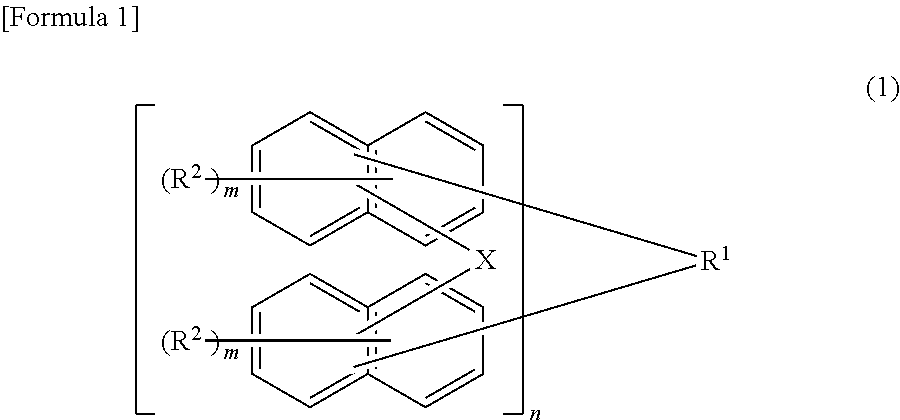Material for forming underlayer film lithography, underlayer film for lithography and pattern forming method
a technology of lithography and film, applied in the field of material for lithography and film underlayer, can solve the problems of difficult to achieve the resist pattern having a film thickness sufficient, and the intrinsic limitation of the wavelength of light source, and achieve excellent heat resistance and etching resistance, high heat resistance, and high carbon concentration
- Summary
- Abstract
- Description
- Claims
- Application Information
AI Technical Summary
Benefits of technology
Problems solved by technology
Method used
Image
Examples
synthesis example 1
Synthesis of BisN-1
[0137]To a container having an inner volume of 100 ml, equipped with a stirrer, a condenser tube and a burette, were charged 1.60 g (10 mmol) of 2,6-naphthalenediol (reagent produced by Sigma-Aldrich Co., LLC.), 1.82 g (10 mmol) of 4-biphenylaldehyde (produced by Mitsubishi Gas Chemical Company, Inc.) and 30 ml of methyl isobutyl ketone, 5 ml of 95% sulfuric acid was added thereto, and a reaction liquid was stirred at 100° C. for 6 hours to perform a reaction. Then, the reaction liquid was concentrated, 50 g of pure water was added thereto to precipitate a reaction product, and the resultant was cooled to room temperature followed by filtration for separation. A solid obtained by filtration was dried, and separated and purified by column chromatography to thereby provide 3.05 g of an objective compound (BisN-1) represented by the following formula.
[0138]Herein, the following peaks were observed by 400 MHz-1H-NMR, and it was confirmed that the compound had a chemic...
synthesis example 2
Synthesis of BisN-2
[0145]Except that 3.20 g (20 mmol) of 2,7-naphthalenediol (reagent produced by Sigma-Aldrich Co., LLC.) was used instead of 3.20 g (20 mmol) of 2,6-naphthalenediol, the same manner as in Synthesis Example 1 was performed to thereby provide 0.2 g of an objective compound (BisN-2) represented by the following formula.
[0146]As a result of organic element analysis, the carbon concentration and the oxygen concentration of the resulting compound (BisN-2) were 84.5% and 10.3%, respectively. The carbon content rate is high and the oxygen content rate is low, and it is thus found that the etching resistance is high.
[0147]The molecular weight of the resulting compound was measured by the above method, and as a result, it was 464.
[0148]NMR measurement of the resulting compound was performed under the above measurement conditions, and the following peaks were observed. It was confirmed that the compound had a chemical structure of the following formula.
[0149]δ (ppm) 9.7 (2H, ...
synthesis example 3
Synthesis of BisN-3
[0152]Except that 3.20 g (20 mmol) of 1,5-naphthalenediol (reagent produced by Sigma-Aldrich Co., LLC.) was used instead of 3.20 g (20 mmol) of 2,6-naphthalenediol, the same manner as in Synthesis Example 1 was performed to thereby provide 0.2 g of an objective compound (BisN-3) represented by the following formula.
[0153]As a result of organic element analysis, the carbon concentration and the oxygen concentration of the resulting compound (BisN-3) were 84.5% and 10.3%, respectively. The carbon content rate is high and the oxygen content rate is low, and it is thus found that the etching resistance is high.
[0154]The molecular weight of the resulting compound was measured by the above method, and as a result, it was 464.
[0155]NMR measurement of the resulting compound was performed under the above measurement conditions, and the following peaks were observed. It was confirmed that the compound had a chemical structure of the following formula.
[0156]δ (ppm) 9.7 (2H, ...
PUM
| Property | Measurement | Unit |
|---|---|---|
| temperature | aaaaa | aaaaa |
| temperature | aaaaa | aaaaa |
| temperature | aaaaa | aaaaa |
Abstract
Description
Claims
Application Information
 Login to View More
Login to View More - R&D
- Intellectual Property
- Life Sciences
- Materials
- Tech Scout
- Unparalleled Data Quality
- Higher Quality Content
- 60% Fewer Hallucinations
Browse by: Latest US Patents, China's latest patents, Technical Efficacy Thesaurus, Application Domain, Technology Topic, Popular Technical Reports.
© 2025 PatSnap. All rights reserved.Legal|Privacy policy|Modern Slavery Act Transparency Statement|Sitemap|About US| Contact US: help@patsnap.com



